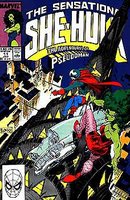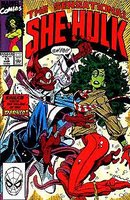Byrne left the book after issue #8 over a creative dispute with the editor. The next issue was a fill-in, following much the same tongue-in-cheek format, and Steve Geber arrived for #10 with artist Bryan Hitch ready to take the book in a new direction.
What's immediately noticeable is that the fourth wall is put back into place. She-Hulk no longer discusses plot points with the reader, or takes advantage of the comic book medium. It appears to have shifted back to a relatively standard superhero title. Steve also makes a drastic shift away from the legal aspects of the book by having She-Hulk's boss fire her in that same issue. Despite her various attempts over the years to fit in with the Avengers, the Fantastic Four, or even the District Attorney's office, she's now cast adrift and pushed to the margins of the superhero set. Under John Byrne, She-Hulk saw mainstream guest-stars like Spider-Man and Mr. Fantastic. Those are gone entirely now, leaving her to contend with Gerber's own creations like: Howard the Duck, Pseudoman, Tillie the Hun, and Nosferata.
 The Adventures of Pseudoman
The Adventures of PseudomanGerber's first two issues, as noted above, change She-Hulk's status quo rather dramatically. After being fired, She-Hulk is accosted by billionarie Lexington Loopner. He's the head of a high-tech marketing agency that is able to use "symbols to generate pseudo-meaning for a society that gags on substance." It turns out that a disgruntled employee has stolen a pseudonic imaging helmet that essentially allows the wearer to physically become his/her idealized self-image. The thief expands the helmet's range so that New Yorkers are treated to 20-story tall monsters in the guise of Uncle Sam, Ronald McDonald and ET (well, legal approximations of them, at any rate). She-Hulk eventually stops him by frying the helmet's circuits with a high-voltage cable, for which Loopner offers to continue marketing She-Hulk as a client.
What I find intersting is that the story and message of the piece is deeply hidden, despite the obvious references to Superman, Mickey Mouse, and Star Trek. There really is no commentary on the incorporation of symbols, of the utilization of "pseudo-meaning." They're presented simply as the reality of the world in which we live. Loopner says, quite frankly, "... for approximately a decade now, intellect has been passe. We live in a visceral culture... Law and government are now a show. When they bore or discomfit, attention drifts elsewhere." Communication without content is the way things are. "Reality and perception are two very different things... I'm in the business of managing the latter."
The commentary is actually at the very end of the story, as She-Hulk thinks about Loopner's offer. She chooses to accept that marketing is pervasive and exploitative, and that many people willingly subject themselves to its mercy. But she (and I can't help but assume Gerber is speaking for himself here as well) "just can't see getting involved with all that media manipulation and craziness... I'm conent to lead the lifestyle of the impoverished..." She (and, again, I would assume Gerber) actually like being on the fringe, out from the mainstream, and there's contentment and validity in that.
 Village of the Darned
Village of the DarnedIssue #12 was a fill-in by Peter David, so the next story comes in Sensational She-Hulk #13. The basic story here is simple enough: She-Hulk and Weezi find themselves stuck in a small town, where everyone is completely wholesome. There's no swearing and even the relatively innocent thought of spooning with one's girlfriend literally brings a meteor down onto one's head. It turns out that an alien who survives on psychic energy has taken control of the town pastor who, in turn, has convinced the entire town to repress anything resembling indecency. She-Hulk is able to get a hailstorm of meteors to rain down on her as she tackles the alien, and turns him into a puddle of goo, thereby saving the town.
Here again, She-Hulk has the role of the outsider. Of course, one could argue that the alien was as well when he first appeared, but within the context of the story, it's She-Hulk who's pushed to the fringes of society.
I might take this opportunity to point out that She-Hulk is not left completely isolated. She has with her, as a sidekick of sorts, Weezi Mason -- formerly the Blonde Phantom. Weezi was very much a typical superhero back in the 1940s, but disuse over the intervening years let her age a bit, and she's no longer quite as capable as a bona-fide superhero. One could argue, though, that she bears some similarities to She-Hulk in that regard -- despite her previous involvement with the All-Winners Squard -- she no longer has ties to that group and was left, again, on the margins. One could view that even more literally, since the Blonde Phantom did not see print in any capacity for four decades before she was brought back into the main pages of a printed publication. While bringing the Blonde Phantom back into action was Byrne's idea, isolating her solely with She-Hulk was Gerber's.
Tomorrow, I'll continue looking at Steve Gerber's She-Hulk and discuss "The Cosmic Squish Principle!"






2 comments:
I still have the early issues of this series. I enjoyed Byrne's unusual "breaking the fourth wall" stories, and lost interest after a bit when he left the series. I did return to the She-Hulk series when he did. I have read interviews with some comic book pros who worked for Marvel at this same time, who said that Byrne was a bit of a jerk to his editor at the time, who I think was Bobby Chace.
Yeah, he didn't leave on good terms. Chase was editing Byrne's book and what became She-Hulk: Ceremony by Dwayne McDuffie, Robin D. Chaplik, and June Brigman. As a courtesy, before it was published Chase ran that book by Byrne to make sure there wasn't anything problematic from a continuity perspective. There's a scene in it where She-Hulk is shaving her legs in the bathtub and there's a pile of broken razors next to the tub, with the implicit joke that a regular razor wouldn't stand up to She-Hulk's super-strong hair. Byrne objected on the grounds that it made She-Hulk look stupid for continuing to use a tool that was clearly not up to the task, and she would've done to Reed Richards or someone to get a super-powered, ultra-techie gizmo that would work. Chase basically said it was a just a cute throwaway gag and left it in. Byrne either felt ownership of She-Hulk or thought Chase had somehow promised him some amount of creative control over Ceremony, and left because of that.
I seem to recall that there was VERY heated debated that cropped up behind-the-scenes at the time that ended up involving a lot creators who were siding with Chase or siding with Byrne or whatever, and it bled out into the fan press at the time. I want to say it was Peter David who "broke the story" in Comic Buyers' Guide.
Post a Comment